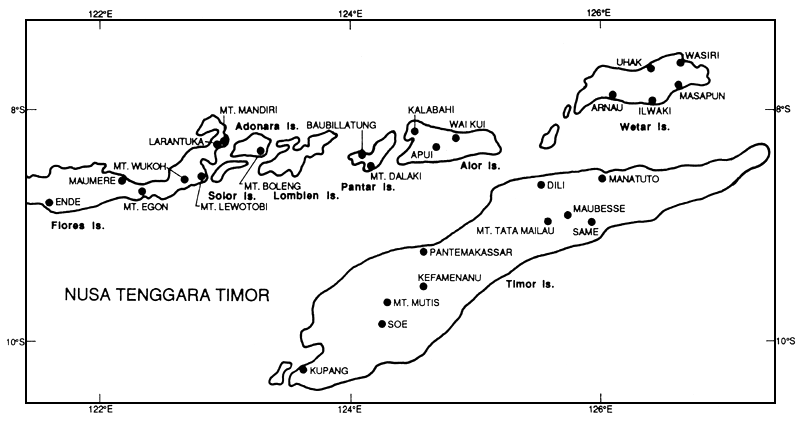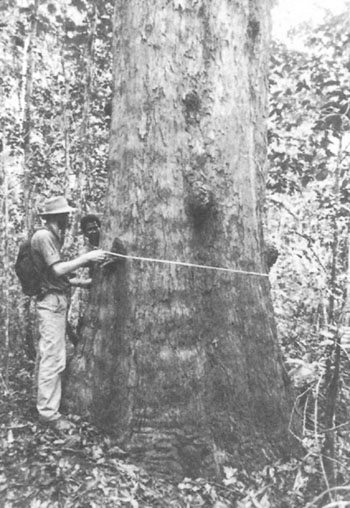by
B.V. Gunn and M.W. McDonald
CSIRO Division of Forestry
P.O. Box 4008, QVT, Canberra 2600
Australia
SUMMARY
During 1990, seed collections of Eucalyptus urophylla S.T. Blake (Timor mountain gum) were undertaken by the CSIRO Division of Forestry's Australian Tree Seed Centre (ATSC) in collaboration with the Indonesian Forestry Department. Seed from 220 individual parent trees was collected from 13 provenances on the islands of Wetar, Alor and Pantar in the Lesser Sunda Islands of Indonesia.
INTRODUCTION
Over most of its natural range E. urophylla is a forest tree usually 25–45 m in height and less than 1 m diameter, with a straight bole for half to two-thirds of the tree height. Exceptional specimens attain 55 m in height and up to 2 m diameter whilst towards its maximum elevation (> 2500 m) it may be a small, gnarled shrub only a few metres in height (Turnbull and Brooker 1978; Jacobs 1981).
E. urophylla is among the priority species identified by the FAO Panel of Experts on Forest Gene Resources for research on taxonomy, germplasm acquisition, provenance trials and breeding.
The species is restricted to seven islands of the eastern Lesser Sunda Archipelago viz. Flores, Adonara, Lomblen (Lembata), Pantar, Alor, Wetar and Timor (see Figure 1). It is particularly common on Timor above 1000 m, Alor and Wetar, but has a patchy distribution elsewhere. Latitudinal range is from 7° 30' to 10° south whilst longitude is from 122° to 127° east, a distance of about 500 km. Altitudinal range is from 70 m on Wetar to 2960 m in east Timor.
The structure of E. urophylla communities and the habit of individual trees appear determined by the interaction of terrain, aspect and edaphic factors. Open woodlands of E. urophylla colonise the exposed south and north-facing ridges at elevations usually above 200 m but occur at 70 m on Wetar and up to 2960 m on Timor. Its apparent preference for elevations above 200 m may be due in part to unfavourable soil (limestone) at lower elevations which are usually dominated by low open woodlands of E. alba or savanna. Tall open forests may develop on basaltic substrates with favourable aspects. These populations may be adjacent to or intergrade with dense rainforest. At the upper limit of its altitudinal range, E. urophylla forms sparse low open woodland. Traditional agricultural activities and the use of fire has greatly reduced the occurrence of E. urophylla except on Wetar island. Extreme differences exist in bark, foliage and fruit morphology between populations and between individual trees within populations. This has been well documented (see Turnbull 1971; Martin and Cossalter 1975/6; Turnbull and Brooker 1978).
The major influences governing the climate of the natural stands are described by Martin and Cossalter (1975–76). In brief, the distribution of the species is in the hot, seasonally dry tropics. Due to the close proximity to the equator, there is only a small range in mean monthly maximum temperatures (27–29 °C at 400 m). The rainfall is monsoonal with a well defined summer maximum and mostly ranges from 700 to 1500 mm with an upper maximum of 2500 mm in Timor.
The first reported seed collection of E. urophylla made specially for provenance research was carried out by M.R. Jacobs and R.W. Evans on Timor in 1963 (Anon. 1964, pp. 47–48) and on Flores and Timor by E. Larson in 1968. This was followed by a series of other collections including those made by C. Cossalter of the Centre Technique Forestier Tropical (CTFT).
The most widespread and largest plantations of this species are in Brazil. In recent times E. urophylla has increased greatly in popularity for plantations in subhumid tropical climates with several months of drought (wet/dry tropics). This has required further research into the genetic diversity of the species. In order to meet this demand, the Australian Tree Seed Centre undertook provenance collections during August and September 1990.
SEED COLLECTION
The collections on Wetar, Alor and Pantar islands are summarized in Table 1. These islands were selected since germplasm material from them was either poorly represented or absent from seed stocks. Seed collections were kept separate by individual trees, and emphasis was placed on sampling low-elevation stands. Seed was gathered by local climbers, who proved most effective. Timing of the collection coincided well with seed crop maturity, though extensive searching was required to locate the required number of trees bearing a desirable crop.
Wetar
Of the chain of seven islands forming the natural distribution of E. urophylla, Wetar is the most easterly and forms part of Maluku Province. The island rises dramatically from sea-level with the majority of the land mass above 200 m. The vegetation in contrast to the other islands is virtually undisturbed and supports extensive stands of E. urophylla down to an elevation of 70 m, the lowest known recording. Access to the island is limited since there is no air service whilst passenger boats run infrequently. It is largely for this reason that collections have seldom been made on Wetar. There is no infrastructure on the island, which is sparsely populated (1200 inhabitants).
Seed was obtained from a total of 146 trees in eight provenances, five from the south side of the island and three from the north. Provenances were selected on the basis of either past knowledge or through the help of villagers who assisted the collection party in locating populations. The species occurred as mostly pure stands either in association with vine forest as in the case of seedlots 17830, 17831 and 17836 or on relatively exposed woodland sites as with seedlots 17832, 17834, 17835 and 17837.
Alor
On Alor three populations were sampled comprising a total of 42 trees. The island is rugged, rising to 1500 m with around 95% of the land above 200 m. Most of the natural vegetation has been removed by the activities of the local population. E. urophylla is now largely restricted to higher-elevation sites over 450 m as remnant forest extending to elevations of over 1250 m.
Pantar
Collections on Pantar were from two populations comprising 18 trees. The island is located to the west of Alor with similar topography and vegetation. As with Alor, much of the natural vegetation had been removed. E. urophylla occurs as disjunct populations above 150 m elevation with the main population at over 400 m, and extending to approximately 1200 m on Mount Topaki in the south-east.
Collections were also made of Casuarina junghuhniana on Timor and Wetar. Collections of E. pellita from south-eastern Irian Jaya undertaken during the same trip are reported in a separate paper (see next article).
The seed from these collections was divided between the collaborators.
SEED AVAILABILITY
Seed material from these collections together with that already in store is available for establishing provenance/progeny trials. Persons interested in obtaining seed should contact: Australian Tree Seed Centre, P.O. Box 4008, QVT., Canberra 2600, Australia, Telex: AA62751, Fax: 61-6-2818266.
ACKNOWLEDGEMENTS
It is a pleasure to acknowledge with thanks the collaboration of the Indonesian Forestry Department. Financial support was provided by the Australian International Development Assistance Bureau, P.T. Indah Kiat and Shell Indonesia.
REFERENCES
Anon. 1964 Annual Report of the Forestry and Timber Bureau for the Year 1963. Dept. of Nat. Development, Canberra.
Jacobs, M.R. 1981 Eucalypts for Planting. FAO Forestry Series No. 11. FAO, Rome.
Martin B. and Cossalter, C. 1975–76 Les eucalypts des iles de la Sonde. Bois et Forêts des Tropiques, 163, 3–25; 164, 3–14; 165, 3–20; 166, 3–22; 167, 3–24; 168, 3–17; 169, 3–13. Centre Technique Forestier Tropical (CTFT), France.
Turnbull, J.W. 1971 Internal report for ATSC records. Unpublished.
Turnbull, J.W. and Brooker, M.I.H. 1978 Timor mountain gum Eucalyptus urophylla S.T. Blake. Forest Tree Leaflet No. 214. CSIRO, Melbourne.
Table 1. Summary of Eucalyptus urophylla seed collections in 1990.
| CSIRO NO. | LOCATION | LAT °(S) | LONG °(E) | ALT M | NO OF TREES | VIAB/10g |
| 17830 | NW Ilwaki, Wetar | 7 54 | 126 26 | 490 | 4 | 2975 |
| 17831 | N of Ilwaki, Wetar | 7 52 | 126 27 | 515 | 33 | 3600 |
| 17832 | Arnau, Wetar | 7 49 | 126 10 | 300 | 34 | 2100 |
| 17834 | Telemar, Wetar | 7 54 | 125 58 | 200 | 10 | 2050 |
| 17835 | Carbubu, Wetar | 7 56 | 125 53 | 175 | 10 | 625 |
| 17836 | Uhak, Wetar | 7 39 | 126 29 | 350 | 38 | 3730 |
| 17837 | Old Uhak, Wetar | 7 36 | 126 31 | 215 | 7 | 3730 |
| 17838 | Lalikki, Wetar | 7 42 | 126 21 | 220 | 10 | 3730 |
| 17839 | SE of Apui, Alor | 8 17 | 124 40 | 1115 | 16 | 1520 |
| 17840 | Wai Kui, Alor | 8 14 | 124 44 | 540 | 10 | 4200 |
| 17841 | Pintumas, Alor | 8 19 | 124 31 | 455 | 16 | 4200 |
| 17842 | Dalaki, SE Pantar | 8 31 | 124 05 | 430 | 9 | 2570 |
| 17843 | Baubillatung, Pantar | 8 20 | 124 02 | 285 | 9 | 4160 |

Figure 1. Islands of the Indonesian Archipelago in which Eucalyptus urophylla occurs naturally.

Figure 2. An aging Eucalyptus urophylla (DBH 170 cm) associated with rainforest, Wetar Island, Indonesia.
1 Manuscript received June 1991.